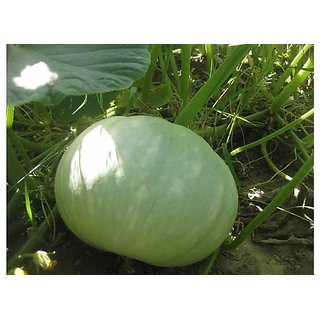Category: Fruit seeds
Scientific Name: Cucurbita Pepo
Color : Orange
Harvest : 95 Days
Plant Spacing : 2-3 plants per hill spaced 5-6' apart
Light Requirements : Sun
Soil & Water Preferences : Average
Climate
Like other cucurbits, pumpkin is essentially a warm season crop, grown mainly in tropical and sub-tropical regions. In temperate countries, forcing cultivation is done mainly in green houses where temperature, humidity, light and carbon dioxide are controlled. Similarly, river bed cultivation of cucorbits during winter months is a kind of indigenous system of vegetable forcing practised with minimum capital outlay, but with maximum risks of growing in low temperature.
Though pumpkin is a warm season crop, the plant withstands cold better than cucumber but is more sensitive to frosts than melons. Regions having a low temperature and high humidity can also grow pumpkin. The plant is also tolerant to shade to some extent.
The average temperature for growth should be around 30-35°C with maximum ranging around 400C and minimum between 20-25°C. Pumpkin seeds germinate well when the day temperature is above 25°C. For normal growth, it requires the optimum average monthly temperature from 25 to 30oC.
Soil
A well-drained soil of loamy type is preferred for pumpkin cultivation. Lighter soils which warm up quickly in spring are usually utilized for early yields. In heavier soils, vine growth will : be more but fruit maturity will be late. The soils should not be waterlogged in rainy season. It is necessary that the soil should be fertile, well provided with the organic matter.
Pumpkin, like other cucurbits, is very sensitive to acid soils. It cannot be successfully grown where pH is below 5.5. The optimum soil pH for pumpkin is between 6.0 to 7.0. The alkaline soils with high salt concentration are also not suitable for its cultivation.
Soil temperature is a determining factor for quick germination, early maturity and production. The minimum temperature of soil should not go below 10°C and the maximum beyond 25°C, the optimum range being around 18-22°C. In river beds, the sands: remains comparatively warmer and does not cool quickly as garden soil. Further, tile sandy river beds have the moisture; beneath and warm up quickly in spring.
Seed and Sowing
Generally two crops of pumpkin are common in plains and sowings are made during January -March and June -July. In the hills, March -June is the common period for sowing. In frost free areas, sowing is done in October which gives the earliest crop in March. In Tamil Nadu sowing is done during August and December -January.
Like other cucurbits, in situ sowing is practised in pumpkin also. In some cases where early crop is desired seeds can be sown in alkathene bags and germinated under protected cover from low temperature. The seedlings are transplanted from the bags at two true leaf stage. However, it may not stand transplanting beyond this stage as tap roots may be damaged. In the case of in situ method, the seeds are sown in well prepared beds about 3.0 m wide at a distance of about 75 cm to 1.0 m apart in tile hills. Each hill is about 50 cm deep and equally wide. Fannyard manure should be mixed with the soil. Three or tour seeds are sown per hill about 2 to 3 cm deep. About 8 kg seed will be sufficient for one hectare field. Where the crop is raised Without irrigation, beds are made and sowing is done in drills 1.5 metre apart and plant thinned later in tile row to a little over one metre.
When the plants have made some growth, they are thinned out to one or rarely two plants per hill. Later on, the vines are allowed to trail on the ground, and generally staking is not required in the case of pumpkin.
Manures and Fertilizers
Pumpkin responds well to manuring and fertilizer application. The doses of fertilizers and manures depend upon tile soil type, climate and variety. In pumpkin, well rotten farmyard manure @ 200 to 250 quintals per hectare is added to the field at the time of land preparation. In addition to this, about 40 kg nitrogen, 80 kg : phosphorus and 40 kg potash should also be given per hectare. Full doses of phosphatic and potassic fertilizers are applied before sowing and one -half dose of nitrogen at the time of vining and the other 10 -15 days later. In pumpkin, excessive nitrogen and consequently enormous vine growth require to be avoided. Besides, high nitrogen under high temperature conditions promotes maleness in flowering. It is better to complete all the fertilizer application before the fruit-set.
Irrigation
In spring summer crop frequency of irrigation is very important. But in rainy season crop, irrigation may not be necessary at all as rainfall is well distributed in July and September. Soil moisture is an important factor governing seed germination in pumpkin. Generally sprouted seeds are planted in spring -summer crop and adequate moisture has to be maintained at the time of emergence. Usually pits, ridges or beds are irrigated a day or two prior to planting of seeds and the next irrigation, preferably light one, is given 4-5 days after planting of seeds. Generally, summer crop is irrigated once in 5 or 6 days depending upon the soil, location, temperature, etc. In river bed system pot watering is practised in the early stages of germination and it is stopped after the roots touch the subterranean moisture region.
Frequent irrigation also promotes excessive vegetative growth especially in heavy soils, which needs to be avoided. Further, one precaution has to be taken that application of water should be restricted to the base of the plant of root zone. Irrigation water should not wet the vines or vegetative parts, especially when flowering, fruit set and fruit development are in progress. Frequent wetting of stem, leaves and developing fruits will promote diseases and rotting of fruits. As far as possible the beds or inter -row spaces should be kept dry so that developing fruits are not damaged.
Usually irrigation frequency is reduced when the fruits reach near maturity and it is completely stopped in the last stages of harvest.
Intercultural Operation
The pumpkin does not require much attention by way of interculture. In the early stages before they start vining, the beds, ridges, etc. require to be kept free from weeds. At the time of top dressing of nitrogenous fertilizers, weeding and earthing up are done. When tile vines start spreading, weeding in between the rows or ridges becomes unnecessary since vine growth can smother the weeds. The only need is that big weeds should be pulled out manually, without disturbing tile vines.
Plant Protection
Pumpkin is attacked by a number of insect pests and diseases. These have been separately discussed in the booklet No. 239 on Insect Pests and Diseases of Cucurbits.
Harvesting and Yield
Harvesting is done depending upon market demand. The fully matured ones keep and cook well. The fruits are cut with a sharp knife with a piece of peduncle attached, which also facilitates handling.
The yield from rainy season crop is more than summer season crop. A good rainy season crop may yield 137 quintals per hectare, while summer season crop yields about 65 to 75 quintals per hectare.
![]()



